engine overheat CADILLAC DEVILLE 1996 7.G Owners Manual
[x] Cancel search | Manufacturer: CADILLAC, Model Year: 1996, Model line: DEVILLE, Model: CADILLAC DEVILLE 1996 7.GPages: 354, PDF Size: 20.32 MB
Page 2 of 354
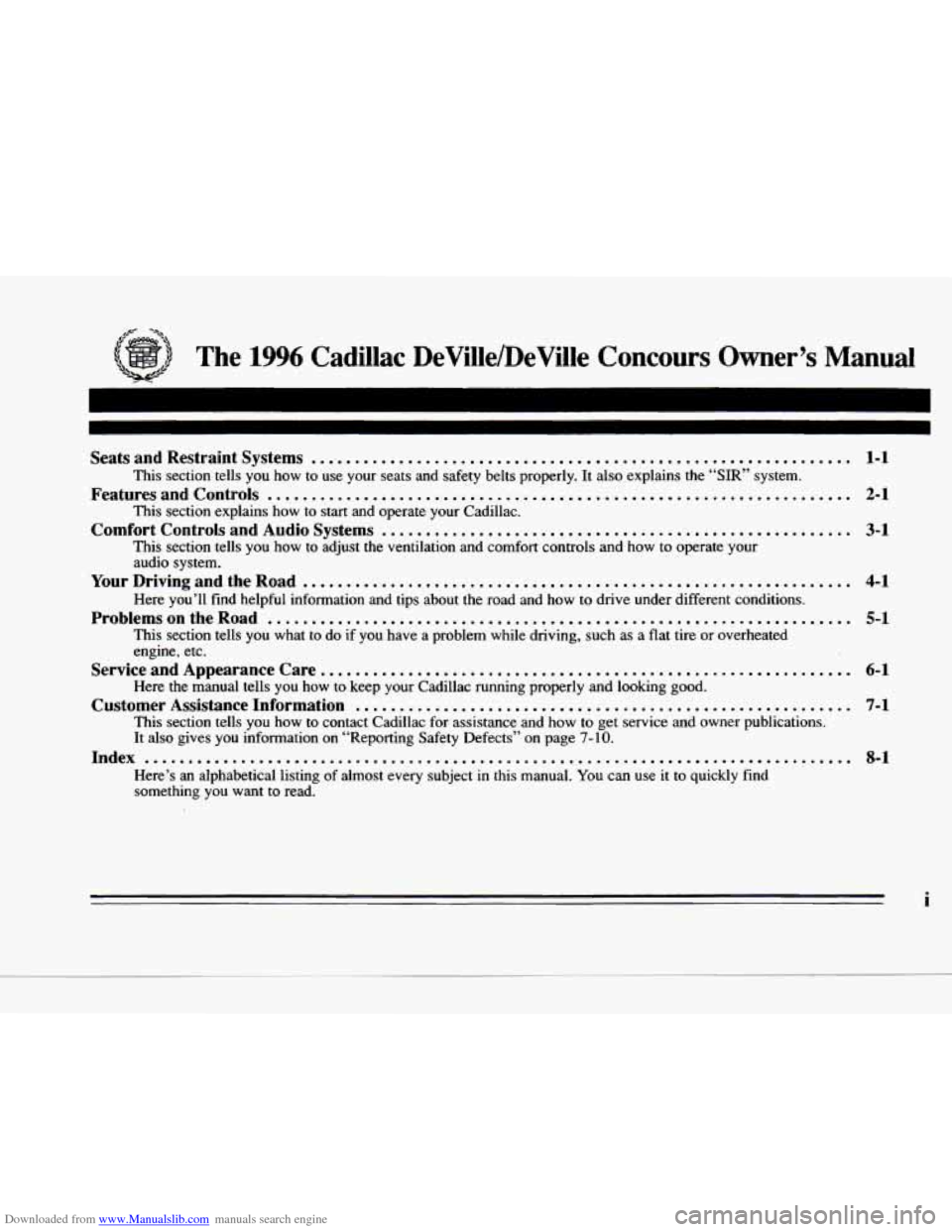
Downloaded from www.Manualslib.com manuals search engine #== -*-
The 1996 Cadillac DeVille/DeVille Concours Owner’s Manual
c
c
c
c
Seats and Restraint Systems ............................................................. 1-1
FeaturesandControls .................................................................. 2-1
Comfort Controls and Audio Systems ..................................................... 3-1
YourDrivingandtheRoad .............................................................. 4-1
This section tells you how to use your seats and safety belts properly. It also explains the “SIR” system.
This section explains how to start and operate your Cadillac.
This section tells you how to adjust the ventilation and comfort controls and how to operate your
audio system.
Here you’ll find helpful information and tips about the road\
and how to drive under different conditions.
This section tells
you what to do if you have a problem while driving, such as a flat tire or overheat\
ed
engine, etc.
Here the manual tells you how to keep your Cadillac running p\
roperly and looking good.
This section tells you how to contact Cadillac for assistance \
and how
to get service and owner publications.
It also gives you information on “Reporting Safety Defects” o\
n page
7- 10.
Here’s an alphabetical listing of almost every subject in this manual. You can use it to quickly find
something you want to read.
ProblemsontheRoad .................................................................. 5-1
ServiceandAppearanceCare ............................................................ 6-1
Customer Assistance Information ........................................................ 7-1
Index ........................................................................\
........ 8-1
c
c
i
Page 81 of 354
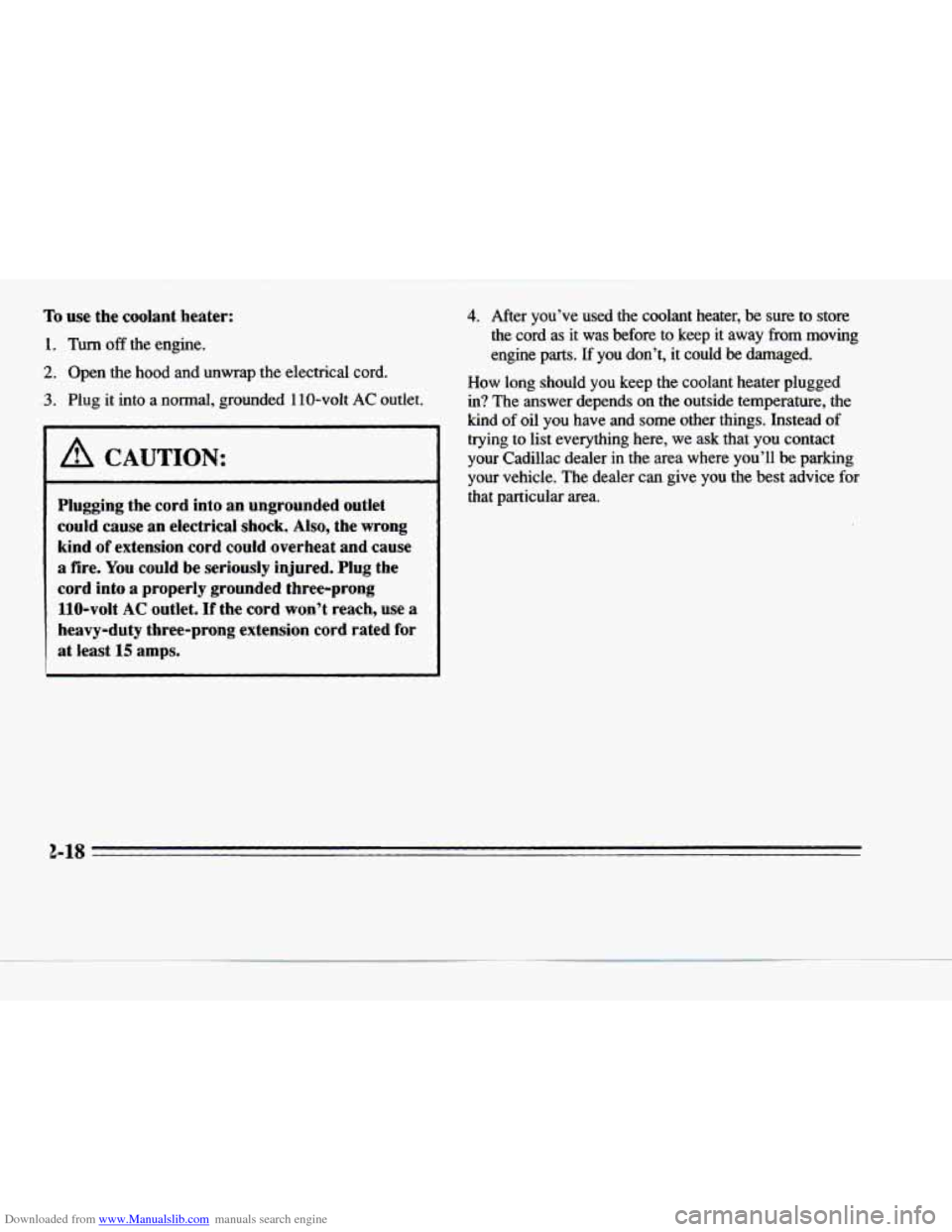
Downloaded from www.Manualslib.com manuals search engine To use the coolant heater:
1. Turn off the engine.
2. Open the hood and unwrap the electrical cord.
.3. Plug it into a nonnal, grounded 110-volt AC outlet.
I A CAUTION:
Plugging the cord into an ungrounded outlet
could cause
an electrical shock. Also, the wrong
kind
of extension cord could overheat and cause
a fire. You could be seriously injured. Plug the
cord into
a properly grounded three-prong
110-volt
AC outlet. If the cord won’t reach, use a
heavy-duty three-prong extension cord rated for
at least 15 amps.
4. After you’ve used the coolant heater, be sure to store
the cord as it was before to keep it away
from moving
engine parts. If you don’t, it could be damaged.
How long should you keep the coolant heater plugged
in? The answer depends on the outside temperature, the
kind
of oil you have and some other things. Instead of
trying
to list everything here, we ask that you contact
your Cadillac dealer in the area where you’ll be parking
your vehicle.
The dealer can give you the best advice for
that particular area.
2-18
-.
Page 85 of 354
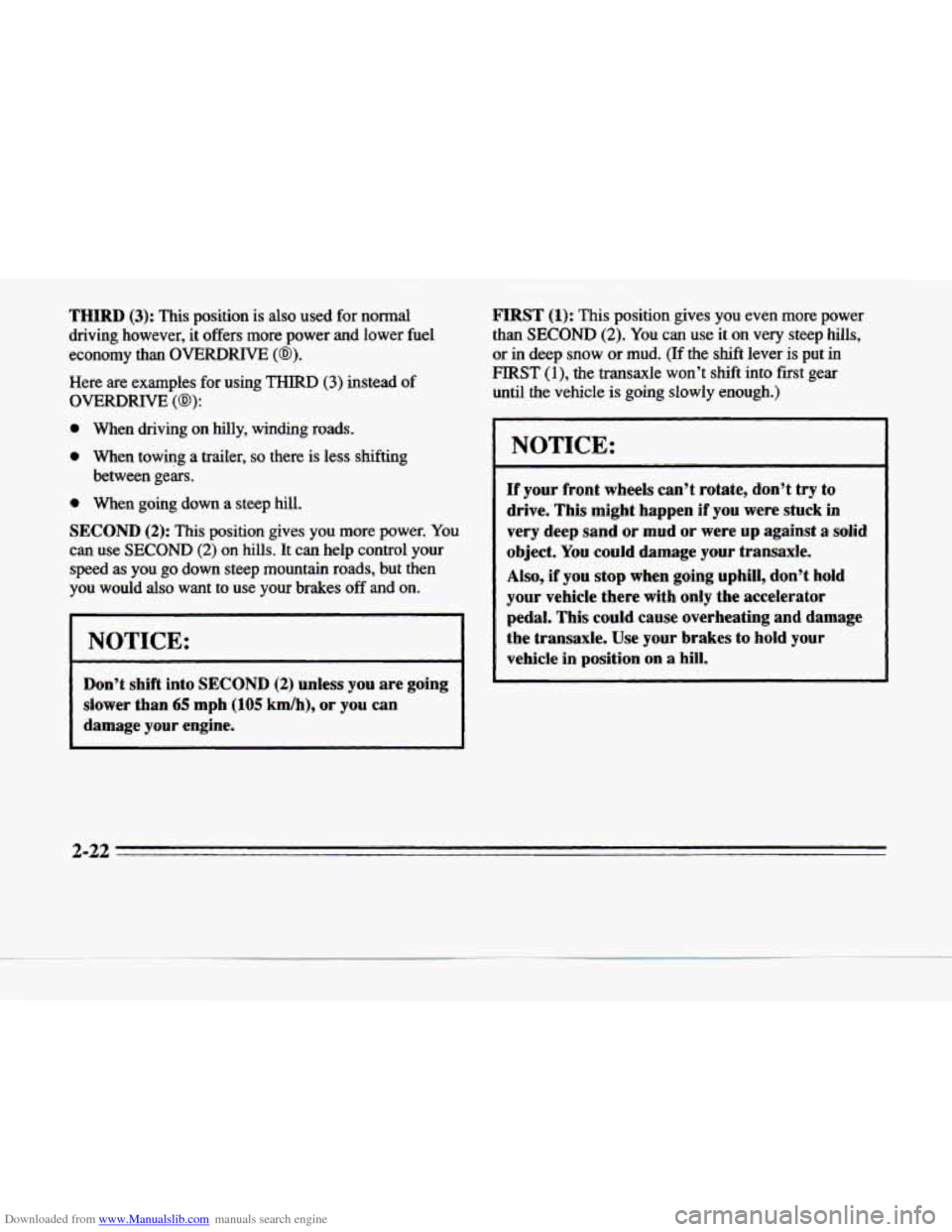
Downloaded from www.Manualslib.com manuals search engine THIRD (3): This position is also used for noma1
driving however,
it offers more power and lower fuel
economy than
OVERDRIVE (0).
Here are examples for using THIRD (3) instead of
OVERDRIVE (@):
0 When driving on hilly, winding roads.
0 When towing a trailer, so there is less shifting
between
gears.
0 When going down a steep hill.
SECOND (2): This position gives you more power. You
can use SECOND (2) on hills. It can help control your
speed
as you go down steep mountain roads, but then
you would also want
to use your brakes off and on.
I NOTICE:
~ ~~ ~~~ ~ ~~~~
Don’t shift into SECOND (2) unless you are going
slower than
65 rnph (105 kdh), or you can
damage your engine.
FIRST (1): This position gives you even more power
than
SECOND (2). You can use it on very steep hills,
or
in deep snow or mud. (If the shift lever is put in
FIRST (l), the transaxle won’t shift into first gear
until the vehicle is going slowly enough.)
I NOTICE:
~~
If your front wheels can’t rotate, don’t try to
drive. This might happen
if you were stuck in
very deep sand or mud or were up against a solid
object,
You could damage your transaxle.
Also, if you stop when going uphill, don’t hold
your vehicle there with only the accelerator
pedal. This could cause overheating and damage
the transaxle. Use your brakes
to hold your
vehicle in position on a hill.
-.
-4
-.
Page 87 of 354
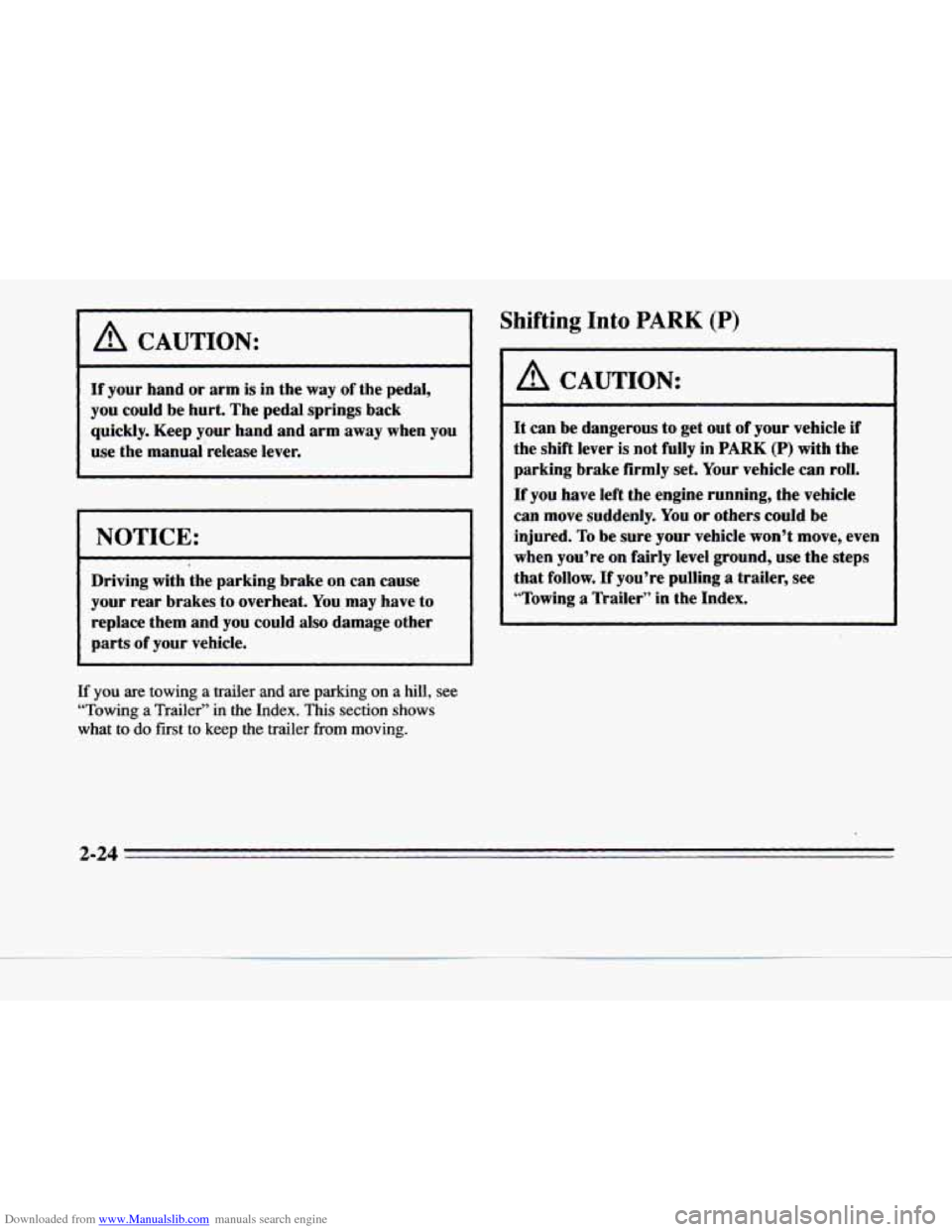
Downloaded from www.Manualslib.com manuals search engine I A CAUTION:
If your hand or arm is in the way of the pedal,
you could be hurt. The pedal springs back
quickly. Keep your hand and arm
away when you
use the manual’release lever.
I NOTICE:
Driving with the parking brake on can cause
your rear brakes to overheat. You may have to
replace them and you could also damage other
parts of your vehicle.
If you are towing a trailer and are parking on a hill, see
“Towing a Trailer”
in the Index. This section shows
what to do first to keep the trailer from moving.
Shifting Into PARK (P)
A CAUTION:
It can be dangerous to get out of your vehicle if
the shift lever
is not fully in PARK (P) with the
parking brake firmly set. Your vehicle can roll.
If
you have left the engine running, the vehicle
can move suddenly.
You or others could be
injured.
To be sure your vehicle won’t move, even
when you’re on fairly level ground, use the steps
that follow.
If you’re pulling a trailer, see
“Towing a Trailer” in the Index.
3 3A
Page 89 of 354
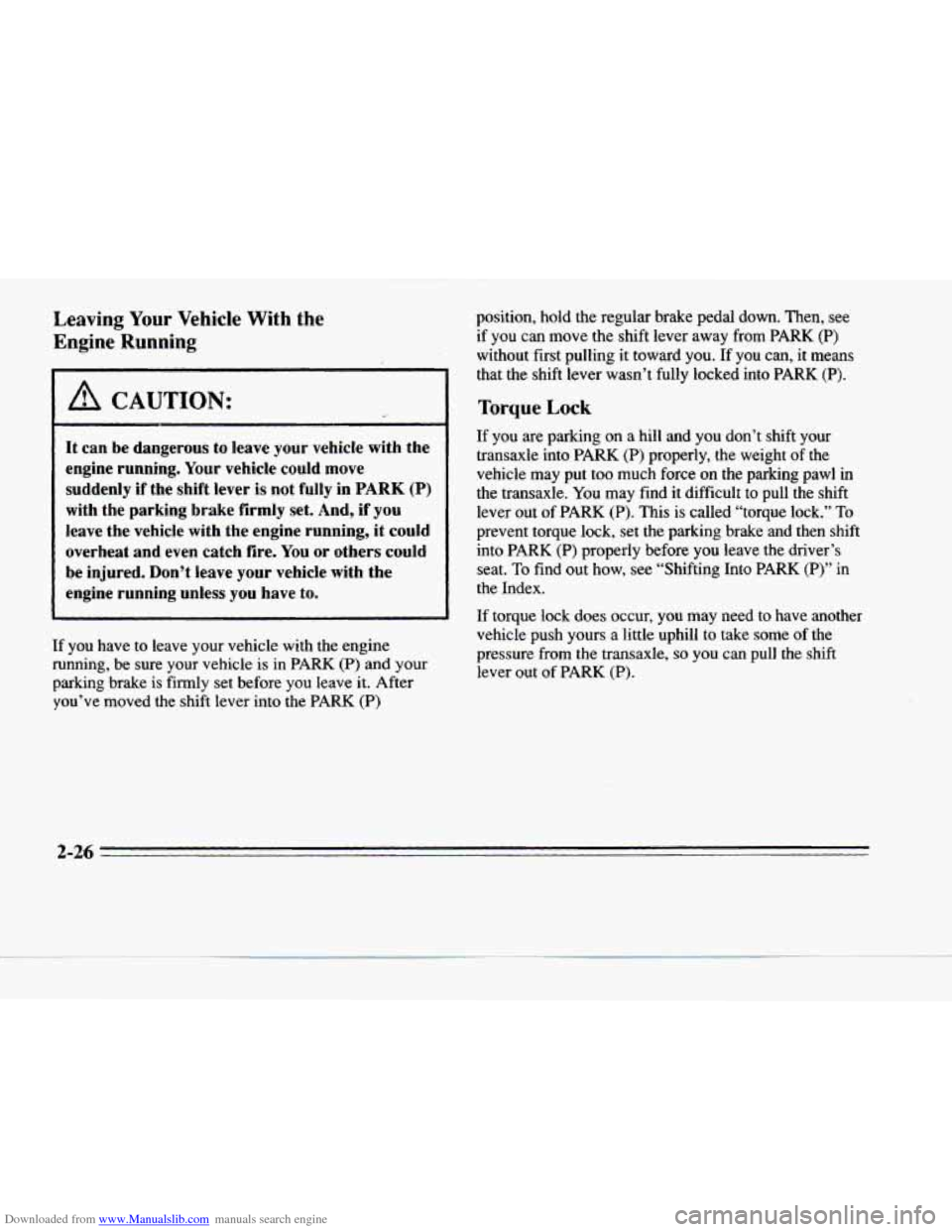
Downloaded from www.Manualslib.com manuals search engine Leaving Your Vehicle With the
Engine Running
I A CAUTION:
It can be dangerous to leave your vehicle with the
engine running. Your vehicle could move
suddenly if the shift lever
is not fully in PARK (P)
with the parking brake firmly set. And, if you
leave the vehicle with the engine running, it could
overheat and even catch fire.
You or others could
be injured. Don’t leave your vehicle with the
engine running unless
vou have to.
I
If you have to leave your vehicle with the engine
running, be sure your vehicle
is in PARK (P) and your
parking brake is firmly
set before you leave it. After
you’ve moved the shift lever into the PARK
(P)
position, hold the regular brake pedal down. Then, see
if you
can move the shift lever away from PARK (P)
without first pulling it toward you. If you can, it means
that the shift lever wasn’t fully locked into
PARK (P).
Torque Lock
If you are parking on a hill and you don’t shift your
transaxle into PARK
(P) properly, the weight of the
vehicle may put too much force on the parking pawl
in
the transaxle. You may find it difficult to pull the shift
lever out of
PARK (P). This is called “torque lock.” To
prevent torque lock, set the parking brake and then shift
into
PARK (P) properly before you leave the driver’s
seat.
To find out how, see “Shifting Into PARK (P)” in
the Index.
If torque lock does occur, you may need to have another
vehicle push yours a little uphill to take some
of the
pressure from the transaxle,
so you can pull the shift
lever out of PARK
(P).
2-26
r
Page 117 of 354
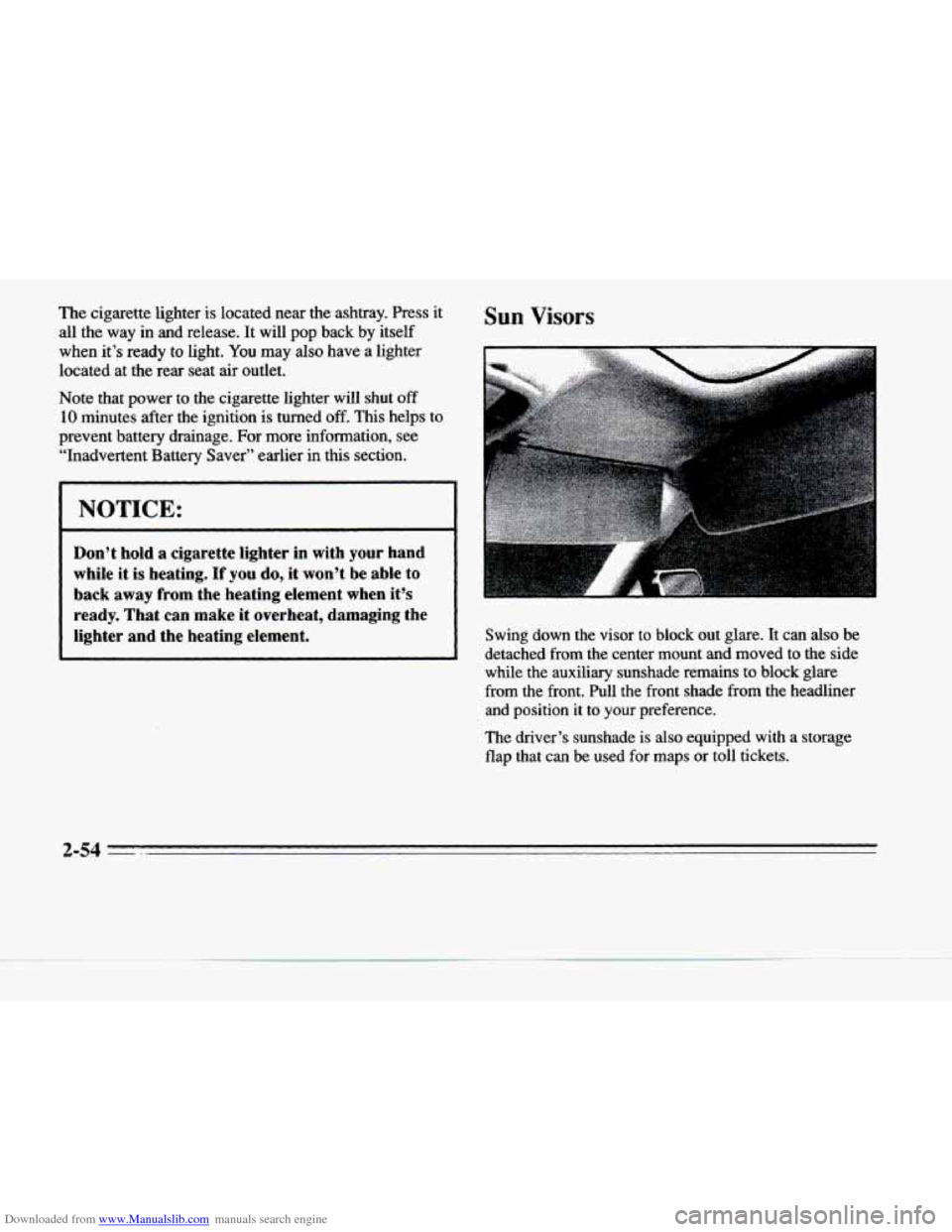
Downloaded from www.Manualslib.com manuals search engine The cigarette lighter is located near the ashtray. Press it
all the way in and release. It will pop back by itself
when it’s ready
to light. You may also have a lighter
located at the
rear seat air outlet.
Note that power to the cigarette lighter will shut
off
10 minutes after the ignition is turned off. This helps to
prevent battery drainage. For more information, see
“Inadvertent Battery Saver” earlier
in this section.
NOTICE:
Don’t hold a cigarette lighter in with your hand
while it
is heating. If you do, it won’t be able to
back away from the heating element when it’s
ready. That can make it overheat, damaging the
Iighter and the heating element.
Sun Visors
Swing down the visor to block out glare. It can also be
detached from the center mount and moved to the side
while the auxiliary sunshade remains to block glare
from the front. Pull the front shade from the headliner
and position it to your preference.
The driver’s sunshade is also equipped
with a storage
flap that can be used
for maps or toll tickets.
-.
Page 131 of 354

Downloaded from www.Manualslib.com manuals search engine The traction control system warning light may come on for the following reasons:
If there’s a brake system problem that is specifically
related to traction control, the traction control system
will
turn off and the warning light will come on.
engine-related problem, the system will
turn off and
the warning light will come
on.
If the traction control system is affected by .an
If the traction control system warning light comes on
and stays on for an extended period of time when the
system is turned
on, your vehicle needs service.
Engine Temperature Warning Light
This red light tells you that
your engine has overheated.
You should stop the car
and
turn the engine off as soon
as possible. A warning
chime should also sound if this light comes on.
As a check, the light should come on for a few seconds
when you start your engine. In the section “Problems on
the Road,” this
manual explains what to do. See “Engine
Overheating” in the Index.
-.
*’ -.
2-68
Page 141 of 354
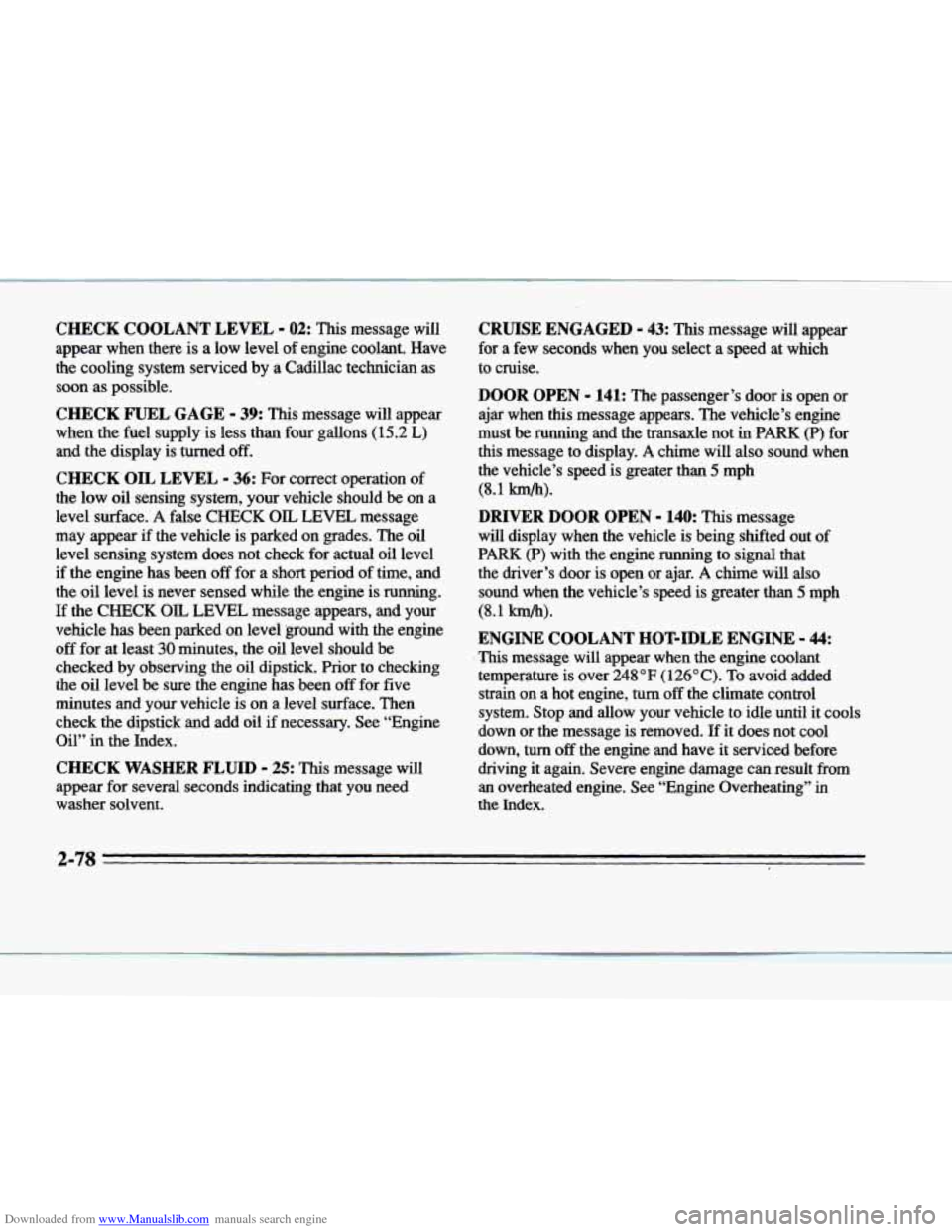
Downloaded from www.Manualslib.com manuals search engine CHECK COOLANT LEVEL - 02: This message will
appear when there is a low level
of engine coolant. Have
the cooling system serviced by a Cadillac technician as
soon
as possible.
CHECK FUEL GAGE - 39: This message will appear
when the fuel supply is less than four gallons (15.2
L)
and the display is turned off.
CHECK OIL LEVEL - 36: For correct operation of
the low oil sensing system, your vehicle should be on a
level surface.
A false CHECK OIL LEVEL message
may appear
if the vehicle is parked on grades. The oil
level sensing system does not check for actual oil level
if the engine has been off for a short period of time, and
the oil level is never sensed while the engine is running.
If the CHECK OIL LEVEL message appears, and your
vehicle has been parked on level ground with the engine
off for at least 30 minutes, the oil level should be
checked
by observing the oil dipstick. Prior to checking
the oil level be sure the engine has been off for five
minutes and your vehicle is on a level surface. Then
check the dipstick and add oil
if necessary. See “Engine
Oil”
in the Index.
CHECK WASHER FLUID - 25: This message will
appear for several seconds indicating that
you need
washer solvent.
CRUISE ENGAGED - 43: This message will appear
for a few seconds
when you select a speed at which
to cruise.
DOOR OPEN - 141: The passenger’s door is open or
ajar when this message appears. The vehicle’s engine
must be running and the transaxle not
in.PARK (P) for
this message to display.
A chime will also sound when
the vehicle’s speed is greater than
5 mph
(8.1 km/h).
DRIVER DOOR OPEN - 140: This message
will display when the vehicle is being shifted out
of
PARK (P) with the engine running to signal that
the driver’s door is open or ajar.
A chime will also
sound when the vehicle’s speed is greater than
5 mph
(8.1 W).
ENGINE COOLANT HOT-IDLE ENGINE - 44:
This message will appear when the engine coolant
temperature
is over 248°F (126°C). To avoid added
strain on a hot engine, turn off the climate control
system. Stop and allow your vehicle to idle until
it cools
down
or the message is removed. If it does not cool
down,
turn off the engine and have it serviced before
driving it again. Severe engine damage can result from
an overheated engine. See “Engine Overheating” in
the Index.
2-78
Page 144 of 354
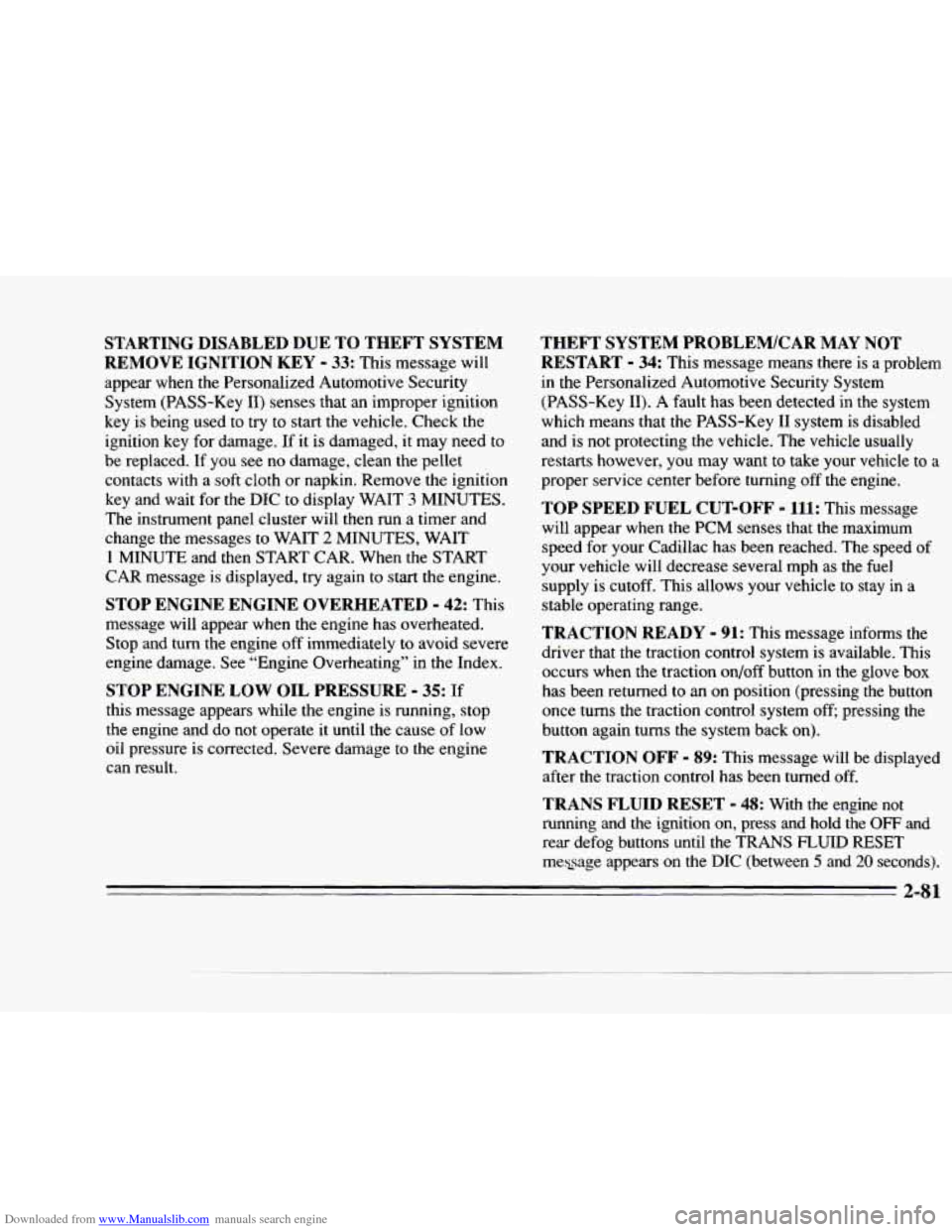
Downloaded from www.Manualslib.com manuals search engine c
.c
c
STARTING DISABLED DUE TO THEFT SYSTEM
REMOVE IGNITION KEY
- 33: This message will
appear when the Personalized Automotive Security
System (PASS-Key
11) senses that an improper ignition
key is being used to try to start
the vehicle. Check the
ignition key for damage. If
it is damaged, it may need to
be replaced. If you see no damage, clean the pellet
contacts
with a soft cloth or napkin. Remove the ignition
key and wait for the
DTC to display WAIT 3 MINUTES.
The instrument panel cluster will then run a timer and change the messages to WAIT
2 MINUTES, WAIT
1 MINUTE and then START CAR. When the START
CAR message is displayed, try again to start the engine.
STOP ENGINE ENGINE OVERHEATED - 42: This
message will appear when the engine has overheated. Stop and turn the engine off immediately to avoid severe
engine damage. See “Engine Overheating” in
the Index.
this message appears while the engine is running, stop
the engine and do not operate it until the cause
of low
oil pressure is corrected. Severe damage to
the engine
can result.
STOP ENGINE LOW OIL PRESSURE - 35: If
THEFT SYSTEM PROBLEMlCAR MAY NOT
RESTART
- 34: This message means there is a problem
in the Personalized Automotive Security System
(PASS-Key 11).
A fault has been detected in the system
which means that
the PASS-Key I1 system is disabled
and is not protecting
the vehicle. The vehicle usually
restarts however, you may want to take your vehicle to a
proper service center before turning off the engine.
TOP SPEED FUEL CUT-OFF - 111: This message
will appear when the PCM senses that the maximum
speed for your Cadillac has been reached. The speed
of
your vehicle will decrease several mph as the fuel
supply is cutoff. This allows your vehicle to stay in a
stable operating range.
TRACTION READY - 91: This message informs the
driver that the traction control system is available. This occurs when the traction on/off button in the glove box
has been returned to
an on position (pressing the button
once turns the traction control system off; pressing the
button again turns the system back on).
TRACTION OFF - 89: This message will be displayed
after
the traction control has been turned off.
TRANS FLUID RESET - 48: With the engine not
running and the ignition on, press and hold the
OFF and
rear defog buttons until the TRANS FLUID RESET
meGage appears on the DIC (between 5 and 20 seconds).
2-81 c
Page 219 of 354
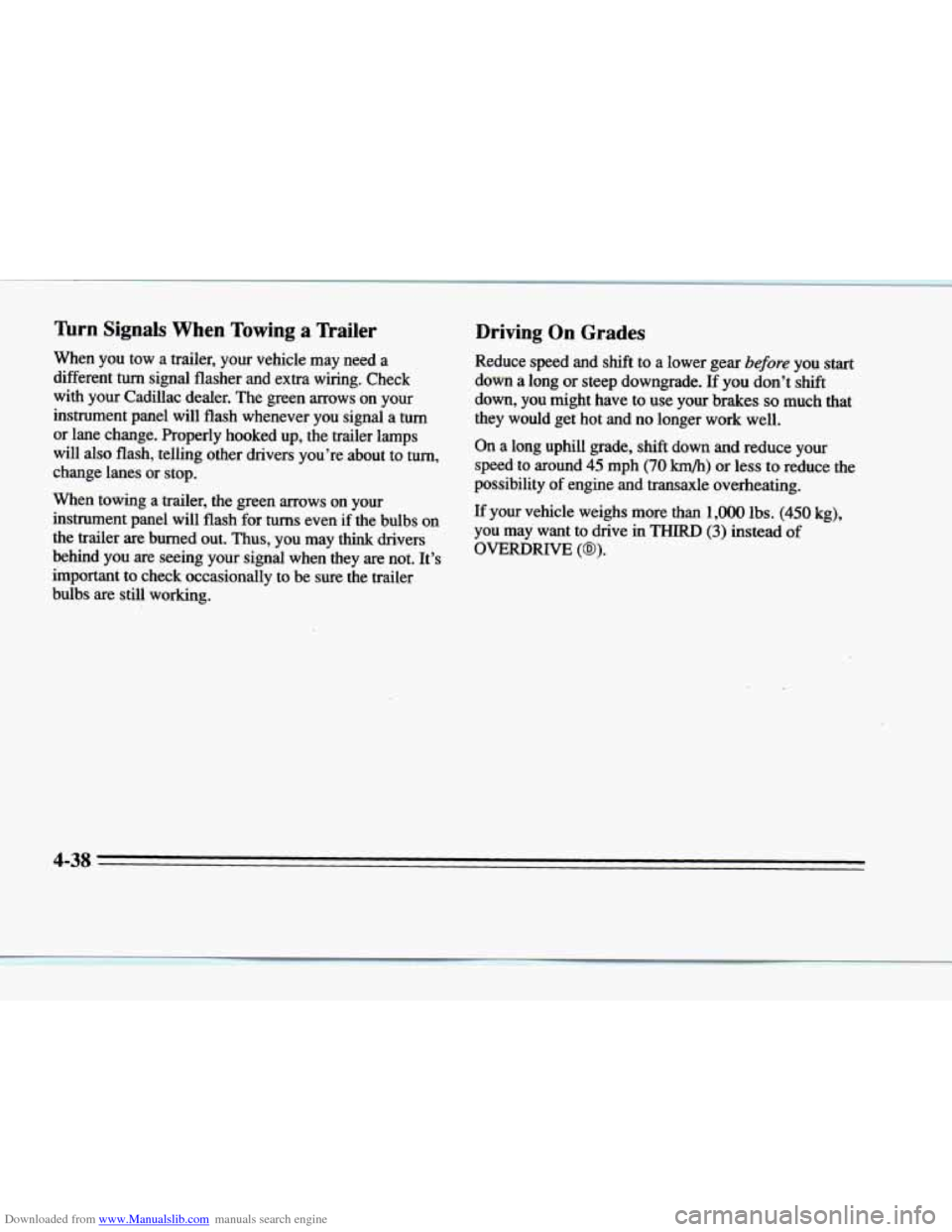
Downloaded from www.Manualslib.com manuals search engine lhrn Signals When Towing a nailer
When you tow a trailer, your vehicle may need a
different
turn signal flasher and extra wiring. Check
with your Cadillac dealer. The green
arrows on your
instrument panel will flash whenever you signal a
turn
or lane change. Properly hooked up, the trailer lamps
will
also flash, telling other drivers you’re about to turn,
change lanes or stop.
When towing a trailer, the green arrows on your
instrument panel will flash for turns even
if the bulbs on
the trailer
are burned out. Thus, you may think drivers
behind you are seeing your signal when they are not. It’s
important to check occasionally to be sure the trailer
bulbs are still working.
Driving On Grades
Reduce speed and shift to a lower gear before you start
down a long or steep downgrade.
I€ you don’t shift
down, you might have to use your
brakes so much that
they would get hot and no longer work well.
On a long uphill grade,
shift down and reduce your
speed to around
45 mph (70 b/h) or less to reduce the
possibility
of engine and transaxle overheating.
If your vehicle weighs more
than 1,OOO lbs. (450 kg),
you may want to drive in
THIRD (3) instead of
OVERDRIVE (@).
4-38